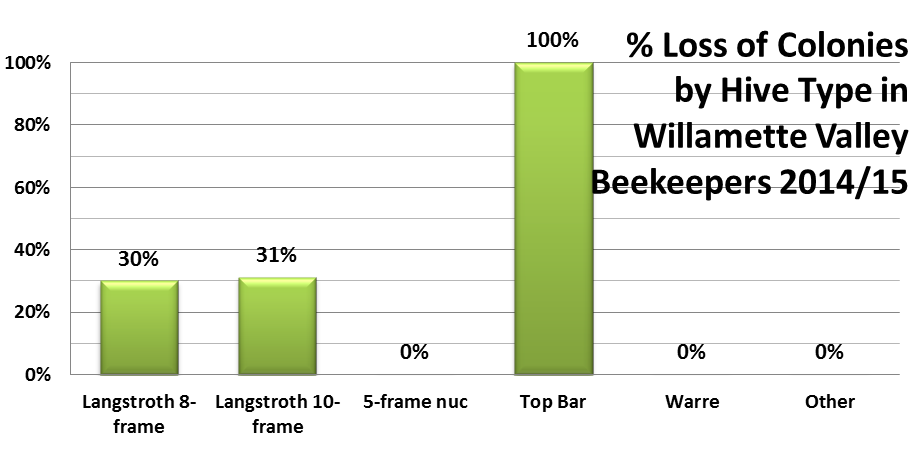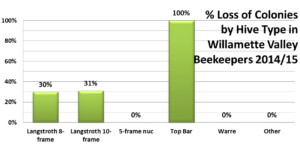At the March and April WVBA meetings I distributed paper copies and directed members to a web-based survey document as a continuing effort to define overwintering success. This was the 7th year of such survey activity. I received 230 responses from OR backyarders, keeping anywhere from 1 to 50 colonies; Willamette Valley members sent in 22 surveys, a third fewer responses compared to the 31 survey returns last year but colony numbers were slightly greater (140 colonies vs 132 last year).
Overwintering losses of WVBA respondents was 42 colonies =30%, just above the statewide loss of 29% (database of 230 OR backyarders.) Losses this past winter were 22% lower than the last 7 years of WVBA losses (38.5%), as reported in previous member surveys.
Loss rate was determined for 8 and 10 frame Langstroth hives, 5-frame nucs, Top Bar, Warré and a category other hive types. WVBA member respondents started winter with 93 Langstroth 10-frame hives (66% of total), 40 Langstroth 8-frame hives, 6 5-frame nucs and 1 Top bar colony; no Warré or other hive types were included. The accompany Figure shows percent loss of each hive type.
Fifty percent (50%) of WVBA members mange 1, 2 or 3 colonies (50%); the largest number was 34. Only one individual had more than one apiary location. Two individuals (9%) moved bees during the year, both to pollinate.
The survey also asked for hive loss by hive origination. Fifty-two of 69 overwintered WVBA colonies were alive in the spring (25% loss rate), a lower loss rate than statewide of overwintering colonies (29% statewide). Respondents reported very similar loss levels of newly established colonies, 60% of packages, 61% of nucs and 57% of swarm captures, all about 1/3 higher than statewide. WVBA beekeepers did better with colony divides (splits) compared to statewide. One of two feral colony transfers did not survive.
Not everyone had loss. Nine individuals (41%) reported total winter survival compared to 48% statewide; 1 individual lost 100% of their colonies. Seventy-two percent indicated acceptable overwinter loss as zero or 5-15%.
Individuals with loss were asked what factor or factors (more than one response was possible) might have led to their colony loss. Weak in the fall, queen failure and varroa mites were the major factors selected, each in 16-19% range, as was I don’t know. Starvation and poor wintering were about equally chosen by about 10%, CCD (6%) and yellow jackets (4%) were selected more frequently than pesticides (4%) or Nosema (2%); Small Hive beetle was not indicated as suspected reasons for loss. WVBA responses (shown in Figure 5 of WVBA report on the wvba winter losses www.pnwhoneybeesurvey.com website mirrored the statewide response
WVBA survey respondents reported a wide range of beekeeping experience. Four individuals (18%) had 18 years or more of bee experience, with the highest 28 years, while 11 (50%) had 1, 2 or 3 years of experience. Thirteen individuals (59%) said they had a mentor available as they were learning their beekeeping, below the 69% so indicating statewide. Club meetings (50%), followed by bee school (18%), were listed as the major source of how respondents received their beekeeping information; the bee school and mentors were listed next.
Remaining survey questions inquired about feeding practices, wintering preparations, sanitation measures utilized and mite controls used, both techniques (such as screen bottom board use, drone brood removal, etc.) and chemical controls. Individuals could check none or more than one response. WVBA members often do not do just one thing to their colony (ies) to control mites and improve overwintering success. Statewide and WVBA responses are presented on the website. Responses will be compared to overwintering loss/success and posted to the www.pnwhoneybeesurvey.com website when compiled.
Two other sections of the survey asked about method and frequency of mite monitoring and about queen replacement by bees or beekeeper. Overall responses have been tallied and posted on the website but I need to complete analysis of responses relative to overwintering loss/success.
There is a lot of data and the strong response from WVBA will enable me to paint a more complete picture of overwintering success for club members. A more complete report of the survey responses, both losses and responses to management questions, presented in easy to understand graphs, is posted at www.pnwhoneybeesurvey.com
Check under survey results (on site top bar) then 2015 survey results WVBA – if you have questions and comments please post them to the site and I will get back to you promptly.
Thanks to all who completed a survey – if you found this, or the more complete website report of use, and you didn’t have a chance to submit your information this year, please consider doing so next April
NOTE: As reported in June BEE LINE, 13 Oregon Commercial & Semi-commercial beekeepers (managing approximately 60% of total estimated colonies in state) reported a 12.4% overwinter loss rate. The BeeInformed survey (a mixture of both large and small-scale beekeepers) reported a 25% OR loss rate.


